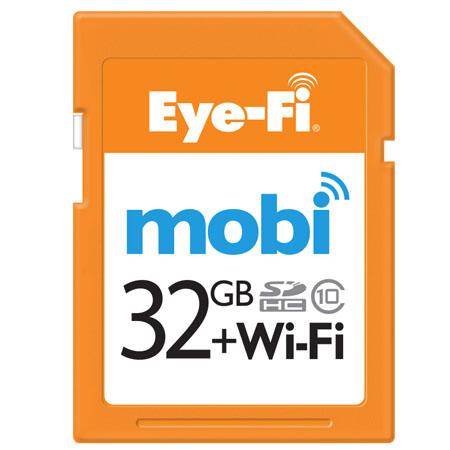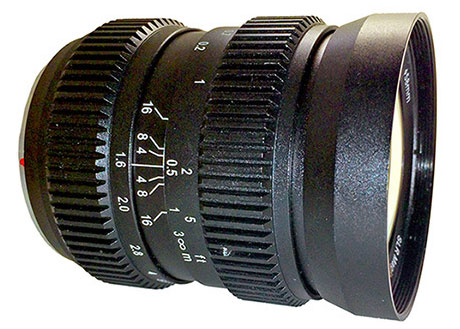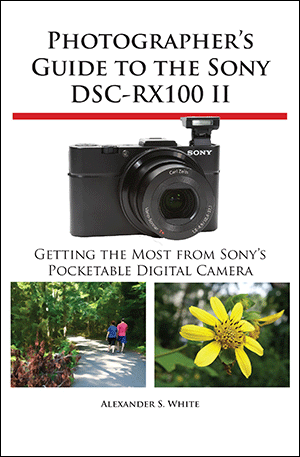
→Eye-Fi launched a new 32GB Mobi wireless memory card

→New SLR Magic HyperPrime 12mm f/1.6 lens for Micro Four Thirds was announced. Here are the specifications:
- Technical Data: SLR Magic HyperPrime CINE 12mm T1.6 w/ Gear
- Lens Type: Ultra Fast wide-angle lens with three Tantalum glass elements to ensure superior cinematic performance.
- Compatible Cameras: All micro four thirds mount cameras
- Optical Design: 12 elements in 10 groups
- Distance Settings: Distance range: 0.15m to ∞, combined scale meter/feet
- Aperture: Manually controlled diaphragm, 12 aperture blades (circular), Lowest value 11
- Bayonet: Micro Four Thirds
- Filter Mount: internal thread for SLR Magic 58/77 RING (optional) lens hood for 77mm filter; filter mount does not rotate.
- Lens Hood: SLR Magic 58/77 RING (optional)
- Surface Finish: Black anodized
- Dimensions: approx. 73/81mm (approx. 2.87 /3.18in) (without/with lens hood)
- Largest diameter: approx. 60/79mm (approx. 2.36 / 3.11in) (without/with lens hood)
- Weight: approx. 370g (approx. 13.05oz)
→New book: Photographer’s Guide to the Sony DSC-RX100 II is currently available on Amazon and eBay. More information:
With the release of the DSC-RX100 II camera, Sony has built upon the success of the earlier RX100 model, adding a hot shoe, tilting LCD screen, Wi-Fi capability, upgraded digital sensor, and other enhancements. White Knight Press, which published a well-received guide to the RX100, has just released Photographer’s Guide to the Sony RX100 II, a new book that addresses all of the new features of the RX100 II and includes a full discussion of the many advanced features that are common to both camera models.
With the publication of this book, author Alexander White provides users of the RX100 II with a guide to all operations, features, menus, and controls of the camera. Using a tutorial-like approach, the book shows beginning and intermediate photographers not only how to accomplish things with the RX100 II, but when and why to use the camera’s features. The book does not assume specialized knowledge by the reader as it explains topics such as autofocus, manual focus, depth of field, aperture priority, shutter priority, exposure compensation, white balance, and ISO sensitivity. The book provides details about the camera’s numerous shooting modes as well as its menu options for shooting, playback, setup, and special effects. The book includes complete coverage of the new features of the RX100 II, including the capability to transfer images and videos over a wireless network and to control the camera remotely with a smartphone or tablet.
The book includes nearly 400 color photographs that illustrate the camera’s controls, display screens, and menus. The images also provide examples of the photographs that can be taken using the RX100 II’s Photo Creativity settings, which alter the color processing of images; the Scene shooting mode, with settings that are optimized for various subjects, including landscapes, portraits, and action shots; the Creative Style and Picture Effect menu options, which offer dramatic options for altering the appearance of images; and the camera’s features for continuous shooting and shooting in dim lighting.
In addition, the book provides introductions to more advanced topics such as infrared photography, street photography, astrophotography, digiscoping, and macro photography.
The book includes a full discussion of the video recording abilities of the RX100 II, which can shoot high-definition (HD) video with stereo sound, and which offers manual control of exposure and focus during movie recording.
In three appendices, the book provides information about accessories for the RX100 II, including cases, external flash units, viewfinders, and filter adapters, and includes a list of web sites and other resources for further information. The book includes an appendix with “quick tips” on how to take advantage of the camera’s features in the most efficient ways possible.
This guide to the RX100 II includes a detailed index, so the reader can quickly find needed information about any particular feature or aspect of the camera.

→Two new Hoya filters were announced:
Hoya PROND line of neutral density filters with ACCU-ND technology:
- The ACCU-ND technology in the Hoya PROND filters yields a truly neutral color balance that
- will not add any noticeable color-cast to your images. The Hoya PROND series is aimed at the still photography and HDSLR video markets. The series provides 9 filters from two stop to 10 stop light reduction.
- The Metallic ACCU-ND coating on the PROND filters do not color shift as you move from one density to the next, a common problem with other series of neutral density filters. Now you can set your white balance once and have the same color balance even if you need to change filters due to changes in lighting, or for creative effect.
- The PROND filters use Hoya’s exclusive clear optical glass that has a metallic ACCU-ND coating front and back to create the neutral density affect.
- Neutral density filters are designed to reduce the amount of light entering your camera lens and should not have any other effect on the image. Reducing the amount of light allows for the use of wider apertures or slower shutter speeds for creative and dramatic effect in bright lighting conditions.
- All Hoya PROND filters have a low-profile one piece aluminum frame. The thin frame keeps the glass secure and parallel to the sensor while allowing it to be used with super-wide angle lenses.
Hoya GRADUATED ND10 graduated neutral density filter:
- The GRADUATED ND 10 balances exposure between the lightest and darkest areas of a scene allowing better tone and detail to be recorded in these areas of the image.
- The Hoya GRADUATED ND 10 is darker at the top giving that area a 3-stop light reduction and then fading evenly to a 1 stop light reduction at the bottom. This creates more balanced exposure between the lighter and darker areas of a scene, especially useful for photos that include the sky. The aluminum filter frame rotates so the darkest area can be positioned as needed.
- The Hoya GRADUATED ND 10 filter uses a Hoya super clear optical glass in a wedge layer that is matched and perfectly bonded to a ND filter glass wedge layer to create the gradual ND effect.
- Neutral density filters are designed to reduce the amount of light entering your camera lens and do not have any other effect on the image. Reducing the amount of light allows for the use of wider apertures or slower shutter speeds for creative and dramatic affect in bright lighting conditions.




